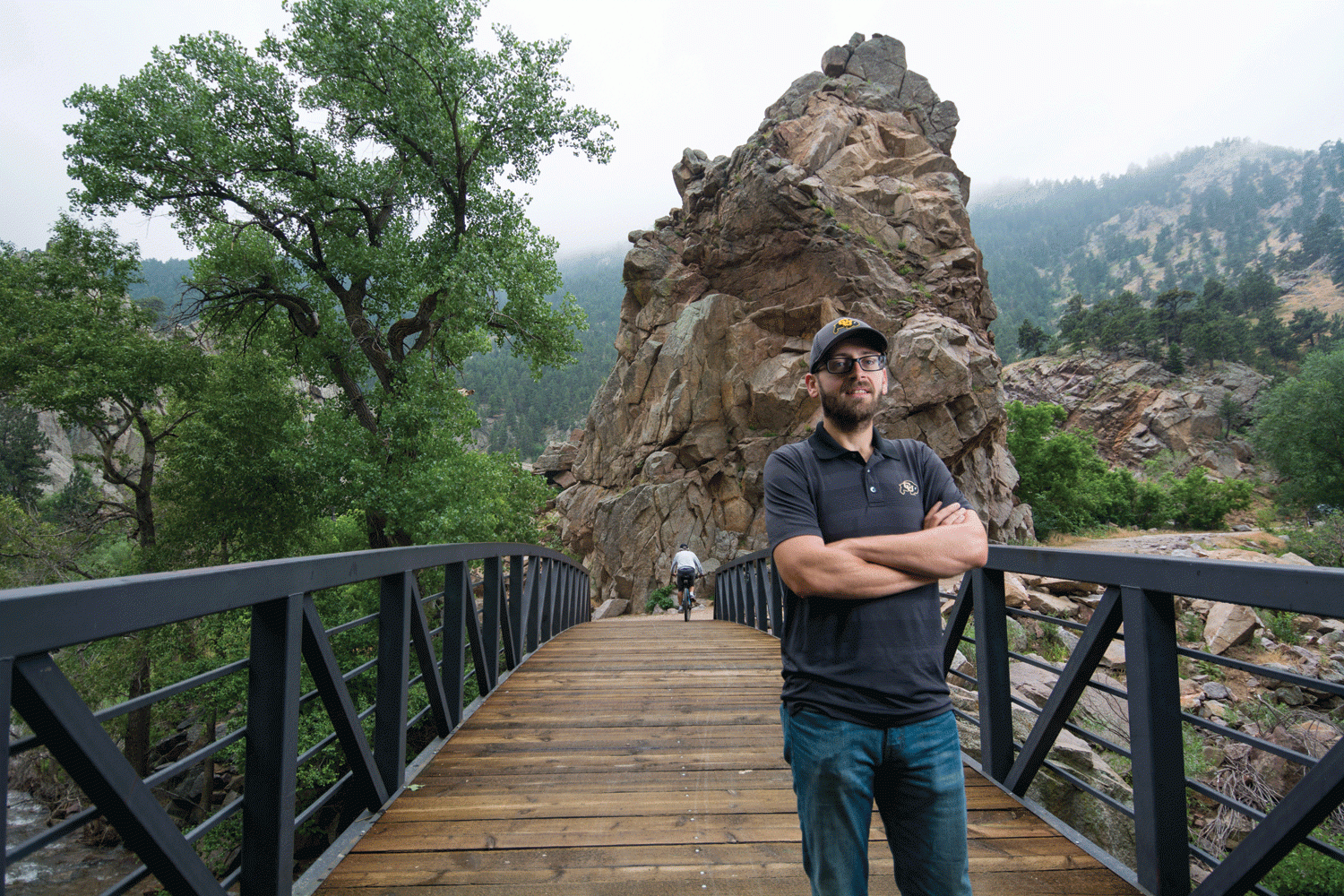
The Bike

Rob Foster’s hands are full.
The 34-year-old CU Boulder senior is married with four children, all daughters. He’s loaded up on physiology, biomechanics and anthropology courses and knee-deep in medical school applications.
He’s also leading a small research team in the development of a bicycle for a potentially vast ridership — obese people of up to 450 pounds.
Foster (IntPhys’16) used to be one of them.
“I have a lot of empathy for people who are in that position,” the now-slender former banker said in a spring interview at the Locomotion Lab in the Clare Small Arts & Sciences building.
Hard at work for more than a year now, Foster’s team aims to produce a final prototype by the end of 2016 and make the design publicly available at no charge.
“Take it. Apply it. Use it,” he said, emphasizing that the group has no commercial intentions. “Help some folks drop some pounds.”
Foster, 5’11”, knows the burdens of obesity. Four years ago he weighed 327 pounds.
“My earliest memories are of being picked on,” he said.
But in early 2012 Foster and his wife, Jessica, decided to slim down. They’d seen obesity’s toll on others, and their weight was keeping them from fully enjoying life with their girls, including twins Autumn and Abigail, now 9.
“We couldn’t go out to the playground,” he said.
Jessica did Zumba; Foster took up tennis, then started jogging and cycling.
Using Google Scholar, Foster, then working as a bank manager, dug into the academic literature about obesity, looking for guidance and understanding. He and Jessica set what felt like reasonable goals (lose two pounds a week) and let themselves continue eating foods they liked, but at far smaller portions. Their success landed them on Good Morning, America.
Today Foster is a trim 172 pounds. He wears eyeglasses with rectangular lenses, a close-cropped, neatly trimmed beard and often a baseball cap. He’s finished two marathons and the BolderBOULDER 10K three times. He gets around town on an off-the rack Fuji. You’d never know he was once seriously overweight.
But millions of Americans are — about 80 million, according to the Centers for Disease Control, or 35 percent of the adult population. Foster wants to improve the odds they’ll slim down, and he and his academic adviser, Rodger Kram, think a customized bicycle could help.
“For very heavy people, even walking, let alone jogging, imparts high forces on the hip, knee and ankle joints,” said Kram, a CU integrative physiology professor. “Swimming is another form of aerobic exercise, but many people are not comfortable wearing bathing suits in public. Bicycling is a fun, social and low-impact way to get aerobic exercise and hence burn calories.”
Foster grew up in Westminster, Colo., a strong high school student keen on science. He briefly attended the University of Northern Colorado, but dropped out. He married, had kids and spent nearly a decade in retail banking. Occasionally he rued quitting school; he’d seen himself as a medical doctor.
Emboldened by his successful weight loss and encouraged by Jessica, Foster decided in 2012 that it wasn’t too late. A year later he enrolled at CU and dove headfirst into the study of integrative physiology.
Last fall he approached Kram about doing original research. Kram suggested the bike project, attempted once before and suspended after a previous team failed to connect with obese people. After hearing Foster’s story, Kram knew he’d found the right guy.
“‘You have what we would call ‘obese experience,’” Foster recalled Kram saying.
Take it. Use it. Apply it. Help some folks lose some pounds.
So Foster and a fellow undergraduate, an engineer, began working on a bike that’s more comfortable and safer for the obese than off-the-rack bikes, seeking input from heavy riders, including a Boston blogger who writes as “The Fat Cyclist.” The team is developing a bike obese people could ride on Boulder’s bike paths, uphill or down, at greater than walking speed.
Bicycle manufacturers have previously produced bikes for heavy riders, but Foster has found them lacking, especially when it comes to the braking systems, which he called “in no way adequate.”
After testing all available types of bike braking systems, the researchers found the best ones required at least 43 feet and 4 seconds to stop a 450-pound person traveling at 15 mph. The team wants brakes that stop the same rider in 1.5 seconds and no more than 15 feet, in line with existing federal standards for a 170-pound person.
The researchers are not trying to reinvent the bicycle — they’re trying to adapt it, mainly by identifying an optimal combination and configuration of existing parts. The bike will look more or less like regular bicycles, an important point for obese people they interviewed.
“They didn’t want anything that was goofy looking,” Foster said. “They don’t want to be the bear on a bicycle.”
Beyond the brakes, the team is rethinking the wheels and gears, seat post (solid rather than hollow), aspects of frame design (optimal height for the top horizontal crossbar and handlebars) and saddle (a tractor-style seat, perhaps).
The braking system will be the most complex new element, and the challenge is to generate greater braking force without warping any parts. The tentative solution calls for a hydraulic system with two front rotors (as in a motorcycle) and two sets of calipers, effectively doubling the friction on the front tire when the brakes are applied. It also calls for doubling the force applied to the rear wheel.
By spring Foster and team had produced an initial prototype and were raising money through a CU-sponsored crowd-funding campaign to finish the project.
Ultimately they want a bike that appeals to obese riders — but still requires them to work.
“If it’s too easy,” said Foster, “we’re defeating our purpose.”
Photo by Patrick Campbell

